
The Estate - Bevendean History Project

The Bevendean Hospital part 2

Opening of the New Buildings
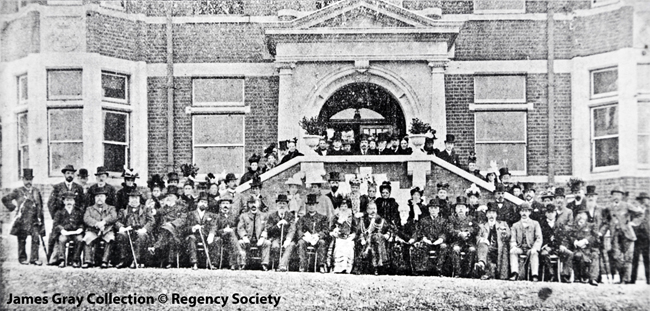
The enlarged hospital was opened on Thursday 27 October 1898 by the Mayor, Alderman Sir John Blaker. The photograph above, taken during the opening ceremony, is from the James Gray Collection in the photographic archive of the Regency Society.
The Mayor said that the buildings had been paid for and would be used by the public for the benefit of all classes.
The British Medical Journal for 5 November 1898 gives the following description of the new buildings.
“The buildings are built with red kiln facing bricks, relieved by Portland stone sills, lintels, copings, etc. The roofs of the entrance lodge, discharge block, and ward pavilions are covered with Broseley tiles; the roof of the administrative block is covered with Bangor slates. All the external walls are built hollow. The drainage of each building is entirely disconnected from the drainage of any other building. Each set of drains being also separately ventilated by its own special inlet and outlet ventilation services.
All the buildings are made as nearly fireproof as is practicable. Thus in all the buildings, except the ward pavilions, the floors consist of wood blocks laid on cement floors. In the ward pavilions the floors consist of terrazzo on the top of the concrete floor.
The buildings throughout are lit by electricity from the Corporation mains. All the buildings are connected with each other by a private telephone.
On the south side of the entrance is the porter’s lodge, containing 1 living room, bedroom, scullery, and kitchen.
The discharge lodge is on the south side of the entrance. It contains undressing-room, bath-room, dressing-room, and waiting-room for friends. In this building patients take their final bath before joining their friends.
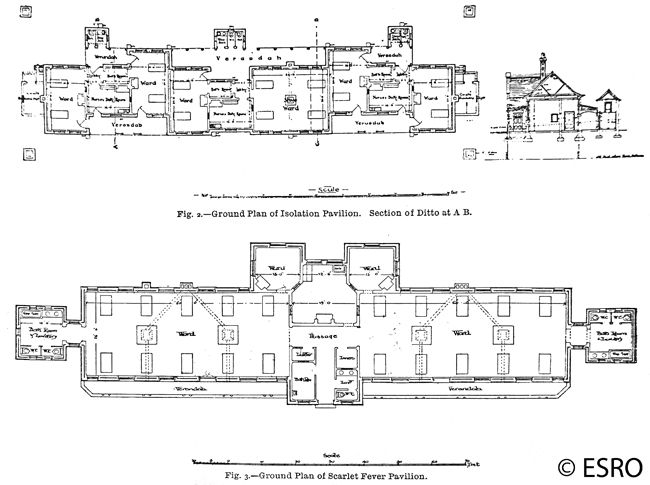
The isolation pavilion consists of 3 distinct, self-contained blocks. The arrangement of these is shown on the ground plan on (Fig. 2). Each block consists of 2 rooms for patients, with a nurse’s duty room between them. The entrances to the two end blocks face westward, that to the middle block eastward. The two end wards have 2 beds in each and are heated by open fireplaces with ventilating grates. The centre block contains 1 ward with 4 beds and 1 ward with two beds, the former being heated by a Shorland’s Manchester stove.
The scarlet fever pavilion (Fig. 3) comprises two wards with 10 beds in each on either side of the nurses’ duty room, which is at the centre of the building. Each ward has an off room attached to it, containing one bed for the treatment of special cases. Each ward is heated by two Shorland Manchester ventilating stoves, and each room by an open ventilating fireplace. The arrangement of lavatories, etc., is shown in the above plan. There is a separate lavatory and water closet for nurses near the main entrance.
Opening of the New Buildings

The enlarged hospital was opened on Thursday 27 October 1898 by the Mayor, Alderman Sir John Blaker. The photograph above, taken during the opening ceremony, is from the James Gray Collection in the photographic archive of the Regency Society.
The Mayor said that the buildings had been paid for and would be used by the public for the benefit of all classes.
The British Medical Journal for 5 November 1898 gives the following description of the new buildings.
“The buildings are built with red kiln facing bricks, relieved by Portland stone sills, lintels, copings, etc. The roofs of the entrance lodge, discharge block, and ward pavilions are covered with Broseley tiles; the roof of the administrative block is covered with Bangor slates. All the external walls are built hollow. The drainage of each building is entirely disconnected from the drainage of any other building. Each set of drains being also separately ventilated by its own special inlet and outlet ventilation services.
All the buildings are made as nearly fireproof as is practicable. Thus in all the buildings, except the ward pavilions, the floors consist of wood blocks laid on cement floors. In the ward pavilions the floors consist of terrazzo on the top of the concrete floor.
The buildings throughout are lit by electricity from the Corporation mains. All the buildings are connected with each other by a private telephone.
On the south side of the entrance is the porter’s lodge, containing 1 living room, bedroom, scullery, and kitchen.
The discharge lodge is on the south side of the entrance. It contains undressing-room, bath-room, dressing-room, and waiting-room for friends. In this building patients take their final bath before joining their friends.

Top drawing - Isolation Pavilion (Fig. 2)
Bottom drawing - Scarlet Fever Pavilion (Fig.3)
Bottom drawing - Scarlet Fever Pavilion (Fig.3)
The isolation pavilion consists of 3 distinct, self-contained blocks. The arrangement of these is shown on the ground plan on (Fig. 2). Each block consists of 2 rooms for patients, with a nurse’s duty room between them. The entrances to the two end blocks face westward, that to the middle block eastward. The two end wards have 2 beds in each and are heated by open fireplaces with ventilating grates. The centre block contains 1 ward with 4 beds and 1 ward with two beds, the former being heated by a Shorland’s Manchester stove.
The scarlet fever pavilion (Fig. 3) comprises two wards with 10 beds in each on either side of the nurses’ duty room, which is at the centre of the building. Each ward has an off room attached to it, containing one bed for the treatment of special cases. Each ward is heated by two Shorland Manchester ventilating stoves, and each room by an open ventilating fireplace. The arrangement of lavatories, etc., is shown in the above plan. There is a separate lavatory and water closet for nurses near the main entrance.
The
floors in the two pavilions are laid with terrazzo. The walls are
lined with opalite to a height of 4 feet 6 inches above the floor line;
above this the walls and ceiling are plastered in Keen’s cement,
painted, and finished flat.
The size of each scarlet fever ward, is 60 by 26 feet; each small room attached to it 13 feet long by 13 feet wide. The size of the large ward in the isolation pavilion is 28 by 24 feet, and the five small wards each 24 by 14 feet.
The administrative building has a half basement containing six living and bedrooms for men servants, kitchen, scullery, and stores. This has a separate external entrance, and owing to the steep slope of the land is scarcely underground. The ground floor comprises visitors’ waiting room, matron’s sitting room, matron’s office, nurses’ dining room, nurses’ sitting room, servants’ room, doctors’ sitting room, dispensary, bacteriological laboratory (with photographic room and lavatories attached), two linen stores, general store room, scullery. On the first floor are eighteen single bedrooms and two double bedrooms, with bathroom, lavatories, etc.
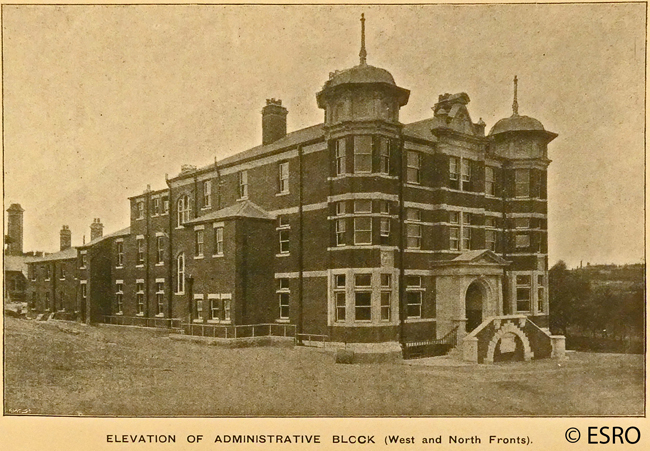
A disinfecting station has been erected, fitted with two steam disinfecting apparatus: one a Washington Lyons (superheated steam) apparatus, having been transferred from the old disinfecting chamber, and a new Deities Defries equifex apparatus (saturated steam under pressure) having been added, the whole of the disinfecting for the town is done here. The contract price of the new buildings was £19,775. It is proposed eventually to supplement the present new accommodation by three additional pavilions.”
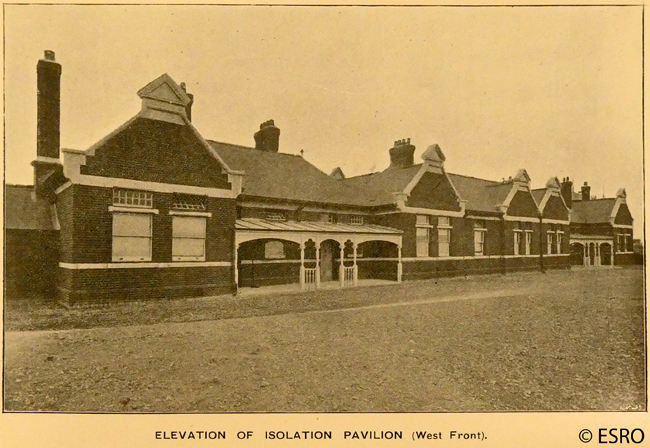
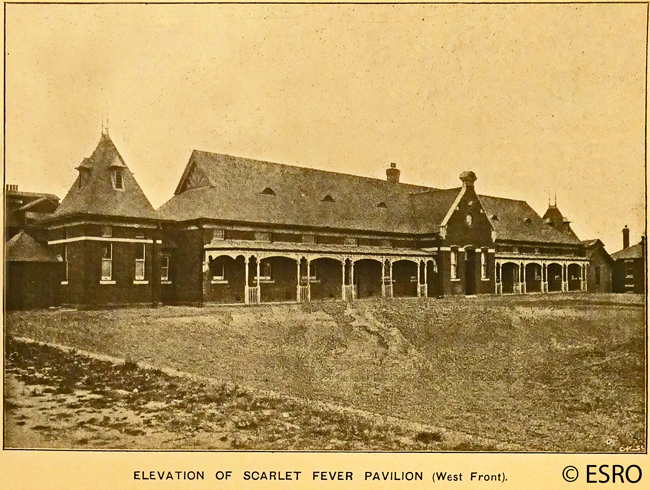
The porter’s lodge on the south side of the entrance gates contained a living room, one bedroom, a kitchen and a scullery. The patients’ discharge block on the north side of the gates had a bathroom, undressing and dressing rooms, and a waiting room for the patients’ friends.
The main gates were of iron and were manufactured by Bruin & Co of Birmingham.
At the time of opening the buildings on the site consisted of:-
1. The Administration Block had four floors, a basement and ground floor for administration; while the first and second floors had bedrooms for some of the staff.
2. An Isolation Pavilion later Ward 3 with just one floor.
3. A Scarlet Fever Pavilion later Ward 4 with just one floor.
4. A Disinfection Station behind the Administration Building.
5. A Discharge Lounge on the north side of the entrance gates.
6. The Porters Lodge on the south side of the entrance gates.
The Local Government Board, in 1898, imposed the condition that the New Sanatorium must not be within half a mile of housing if smallpox patients were to be treated there.
The Council bought a farm on Fulking Hill near Devil’s Dyke in 1901 and converted the farm buildings into an isolation hospital, known as Fulking Grange, for smallpox cases.
continuedThe size of each scarlet fever ward, is 60 by 26 feet; each small room attached to it 13 feet long by 13 feet wide. The size of the large ward in the isolation pavilion is 28 by 24 feet, and the five small wards each 24 by 14 feet.
The administrative building has a half basement containing six living and bedrooms for men servants, kitchen, scullery, and stores. This has a separate external entrance, and owing to the steep slope of the land is scarcely underground. The ground floor comprises visitors’ waiting room, matron’s sitting room, matron’s office, nurses’ dining room, nurses’ sitting room, servants’ room, doctors’ sitting room, dispensary, bacteriological laboratory (with photographic room and lavatories attached), two linen stores, general store room, scullery. On the first floor are eighteen single bedrooms and two double bedrooms, with bathroom, lavatories, etc.

The administrative block and staff bedrooms in 1898
A disinfecting station has been erected, fitted with two steam disinfecting apparatus: one a Washington Lyons (superheated steam) apparatus, having been transferred from the old disinfecting chamber, and a new Deities Defries equifex apparatus (saturated steam under pressure) having been added, the whole of the disinfecting for the town is done here. The contract price of the new buildings was £19,775. It is proposed eventually to supplement the present new accommodation by three additional pavilions.”

The Isolation Pavilion in 1898

The Scarlet Fever Pavilion in 1898
The porter’s lodge on the south side of the entrance gates contained a living room, one bedroom, a kitchen and a scullery. The patients’ discharge block on the north side of the gates had a bathroom, undressing and dressing rooms, and a waiting room for the patients’ friends.
The main gates were of iron and were manufactured by Bruin & Co of Birmingham.
At the time of opening the buildings on the site consisted of:-
1. The Administration Block had four floors, a basement and ground floor for administration; while the first and second floors had bedrooms for some of the staff.
2. An Isolation Pavilion later Ward 3 with just one floor.
3. A Scarlet Fever Pavilion later Ward 4 with just one floor.
4. A Disinfection Station behind the Administration Building.
5. A Discharge Lounge on the north side of the entrance gates.
6. The Porters Lodge on the south side of the entrance gates.
The Local Government Board, in 1898, imposed the condition that the New Sanatorium must not be within half a mile of housing if smallpox patients were to be treated there.
The Council bought a farm on Fulking Hill near Devil’s Dyke in 1901 and converted the farm buildings into an isolation hospital, known as Fulking Grange, for smallpox cases.
